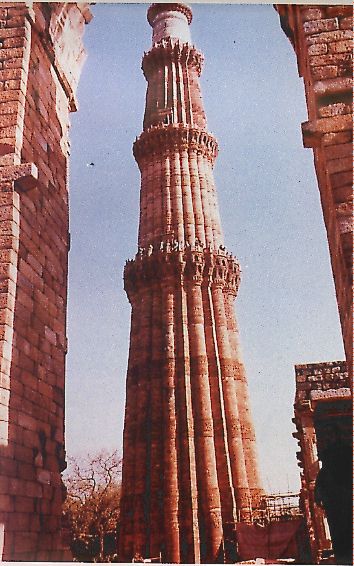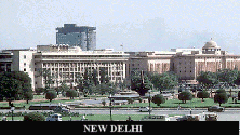Old Delhi, the Moghul Emperor Shah Jahanís seventeenth-century capital, lies 2km or so further north. This is Delhi at its most quintessentially Indian where the traditional lifestyle of its predominantly Muslim population has changed little over two hundred years. A visit to Old Delhi's largest mosque is a must and should be combined with a stroll through the old cityís old bazaars, a warren of clustered houses, buzzing with cosmopolitan and infused with aromatic smells, drifting from open-fronted restaurants, spice shops and temples.
Further south, the other five of Delhi's ex-capitals are today all but deserted, standing as impressive reminders of long-vanished dynasties. Among them you'll find the towering free-standing column erected by Qutb-ud-din Aibak, the Qutb Minar (twelfth century), that marks the first capital, Dhillika, and that signalled the development of the city visitors see today. Walls and dilapidated pillars survive from the fourteenth century city of Tughlaqabad, and Purana Qila, the sixth capital. Interspersed between these historic ruins are the grand tombs of Delhi's former rulers, of which the finest expressions of the Mughal's architectural genius were the grand charbagh (quartered garden) mausoleums of Humayun's Tomb.
Top picks :
Bazaars of Old Delhi
Bazaars(markets) off Chandni Chowk. Bustling alleyways and streets branching of the main avenue leading from the Red Fort. Each bazaar has its traditional specialities - silver, spice, brocade and car parts, for example. (Daily,from 10am)
Nizamuddin's Tomb - Mausoleum
Nizamuddin, Mathura Rd (daily, dawn to dusk). The mausoleum of Sufism's greatest saint, Sheikh Nizamuddin Aulia (1236-1325). Every Thursday evening, haunting religious song and music are played in the courtyard surrounding the tomb.
Parliamentary Buildings - Imperial architecture
Rajpath. Megalithic imperial architecture crowning Raisin Hill: Lutyenís Rashtrapati Bhawan and Bakerís symmetric Secretariats and parliament. At the other end of Rajpath stands India Gate.

Qutb Minar Complex - Hindu, Jain and Muslim monuments
Merauli Rd, South Delhi Sandstone Hindu, Jain and Muslim monuments dating from the eighth to twelfth century, including an ornate tapering minaret and India's first mosque. (Daily, dawn to dusk. Admission Rs 3.)
Red Fort and Jama Masjid
Old Delhi The twin red sandstone and marble monuments marking the opulent epicentre of Shahjchanabad, the Delhi capital of the Moghul Emperor, Shah Jehan. (Daily, dawn to dusk; Red Fort admission Rs 2; Atini Masjid is free).
Bazaars of Old Delhi
Bazaars(markets) off Chandni Chowk. Bustling alleyways and streets branching of the main avenue leading from the Red Fort. Each bazaar has its traditional specialities - silver, spice, brocade and car parts, for example. (Daily,from 10am)
Nizamuddin's Tomb - Mausoleum
Nizamuddin, Mathura Rd (daily, dawn to dusk). The mausoleum of Sufism's greatest saint, Sheikh Nizamuddin Aulia (1236-1325). Every Thursday evening, haunting religious song and music are played in the courtyard surrounding the tomb.
Parliamentary Buildings - Imperial architecture
Rajpath. Megalithic imperial architecture crowning Raisin Hill: Lutyenís Rashtrapati Bhawan and Bakerís symmetric Secretariats and parliament. At the other end of Rajpath stands India Gate.

Qutb Minar Complex - Hindu, Jain and Muslim monuments
Merauli Rd, South Delhi Sandstone Hindu, Jain and Muslim monuments dating from the eighth to twelfth century, including an ornate tapering minaret and India's first mosque. (Daily, dawn to dusk. Admission Rs 3.)
Red Fort and Jama Masjid
Old Delhi The twin red sandstone and marble monuments marking the opulent epicentre of Shahjchanabad, the Delhi capital of the Moghul Emperor, Shah Jehan. (Daily, dawn to dusk; Red Fort admission Rs 2; Atini Masjid is free).
